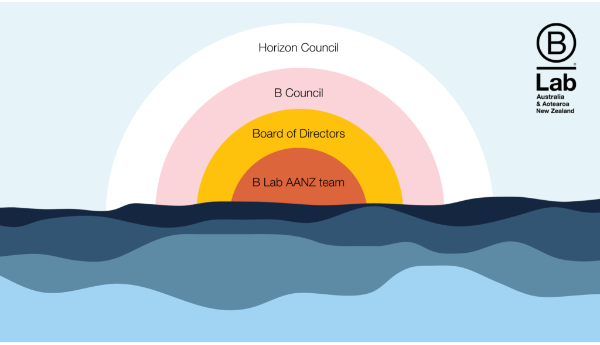governance
Purpose-Led Governance for Mission-Driven Organisations
Published: November 10, 2024
Read Time: 6 minutes

What does it mean to govern with and for purpose? How do we really listen to and account for stakeholder interests? How is impact centred in our work and protected in our governance? How do our governance structures reflect our ambition for systems change?
These are questions we have long been considering at B Lab Australia & Aotearoa New Zealand (AANZ), and questions that are highly relevant to our work as part of a global movement seeking to transform the way businesses operate and contribute to economic systems change for the benefit of people and the planet. In line with the ambitious goal of systems change and the growing needs of the organisation, in 2020 the B Lab AANZ board commenced a journey to reimagine our own approach to governance, and importantly ask whose voices and interests we needed to consider in our structures, systems, and processes.
In this article we set out the case study of evolving the B Lab AANZ Governance Ecosystem, including:
- a description of the process of redesign,
- the specifically tailored governance ecosystem we set up,
- the learnings we have acquired along the way, and
- some recommendations for directors of purpose driven organisations to consider in their own governance practice.
Governing for Impact - B Lab AANZ Governance Ecosystem - a case study
Originally, B Lab AANZ’s governance followed its entrepreneurial origins and was fairly typical of a NFP with a large board representing diverse stakeholders. However, as the management team matured, tensions arose between the large board and operations and it became increasingly clear that the approach that had worked during the establishment phase was no longer fit for purpose and that we needed to change.
Revisiting purpose
The first thing that the B Lab AANZ board considered was the purpose of governance in our context and in relation to our theory of change. After conversations amongst the board, the team and key B corp stakeholders, we identified three distinct governance needs of the organisation (i) overseeing a small non-profit that manages a holistic business certification; (ii) facilitating a rapidly growing network of purpose-led businesses (B Corps) ; and (iii) contributing to the necessary transformation of our economies.
Stakeholder voice
When thinking about the need for change, the board also identified that not having the right voices in the mix could lead to impact drift, undermine integrity and ultimately detract from the organisational purpose. In this case the board recognised that by describing ourselves as a ‘movement’ but not including the voice of the community of B corps in governance was a big risk to organisational integrity.
Widen perspective
This realisation prompted deeper questions about governance approaches and led to the board investigating three different approaches to governance; Corporate, Cooperative, and Indigenous. Considering case studies of these approaches helped us to learn that while corporate governance emphasises optimising organisational performance, cooperative governance is centred on democratic member control and concern for community. Indigenous governance highlighted principles like relationship, attunement, responsive leadership, and respect.
The governance ecosystem
Ultimately, the board decided that in order to meet the distinct and different roles of governance, B Lab AANZ required a governance system with multiple forums. These would be informed by relevant aspects of Corporate, Cooperative and Indigenous approaches, and need to work together coherently.
In addition to a small agile board focussed on fiduciary duties and oversight, we established two other forums which allow for the role of community convenor and systems change advocate to be reflected.
- A “B Council” - a forum made up of certified B Corps to deliberate, protect their shared interests, and mobilise the regional network for greater influence and impact.
- A “Horizon Council” - a forum intended to create space for longer-term sense-making and cooperation with other entities, networks, and movements with aligned goals.

This evolved governance model was designed to formalise more voices and perspectives in the governance, while maintaining essential decision-making and control with the board. The vision for this governance ecosystem was that the B Council and the Horizon Council interact and intersect with the B Lab AANZ board and team in ways that allow for increased insight and information flows, deepened relationships and greater accountability for decisions.
The learnings so far
Four years on, our reflections include:
- The original intention of the design is holding up and the forums and people who have volunteered to bring them to life have been able to manage the different roles of each forum.
- Implementation has taken longer than expected and we, as Directors, have had to grow into new governing mindsets and practices.
- We’re building the containers in advance of their obvious utility—this has sometimes called us to question whether we are over-elaborating on the design of our arrangements. BUT the new arrangements have also been validated as we have been better able to respond to a number of events arising and emerging trends.
- The Horizon Council could become a shared forum that provides an extension of and overlap between the governance arrangements of multiple organisations and networks.
- While governance is primarily understood as the process of making and enforcing decisions within an organisation (Bevir, 2012), in a systems context we can also understand governance as a process of enabling and maintaining coherence - informing and negotiating decisions, and ensuring they are attuned to the wider, changing environment.
Useful questions for directors
When it comes to for purpose organisations/not-for-profits, it is incumbent on boards to ensure that the approach to governance is truly fit for purpose. The following recommendations are informed by the process we went through at B Lab AANZ and can be applied to any purpose driven organisation:
- Revisit the purpose and role of your organisation and the purpose and role governance in your context - be clear on it as a board and management team.
- Create a stakeholder map—Consider which voices are relevant to your governance both from the perspective of potential and opportunity and also from the perspective of risk and mission drift.
- Think outside the box when it comes to governance approaches. You can gain insights from Corporate, Cooperative and Indigenous approaches, just to name a few. Don’t be limited by the form of registration of your entity nor your sector or size when you are looking for inspiration.
- Carefully consider ways to intersect with the broader system you are impacting, intentionally gathering more contextual information and data in your work. This might be through the creation of specific forums (could also be subcommittees, etc.) and other means.
This article was first published in the 2024 Better Boards Conference Magazine.
Further Resources
Which Comes First – the Purpose or the Behaviour?
What Does Good Governance Look Like?
Unleashing the Power of Purpose
Share this Article
Recommended Reading
Recommended Viewing
Author
- About
-
Mele-Ane’s professional background spans the areas of corporate law, human rights and community law,leadership development, strategy, operations, investment management and media. She has worked in Australia (predominantly based in Melbourne and the Kimberley) and overseas (the Netherlands, the UK and the UAE).
Before taking time to care for her young children, Mele-Ane was the founding CEO of Small Giants Academy for two years during its establishment. Prior to that, Mele-Ane held various positions across the Small Giants Impact investment family office including co-CEO, strategy and portfolio manager, and general manager of Dumbo Feather.
Mele-Ane began her career in law, working at Clayton Utz in Australia in corporate law, including governance advisory work and then for international French firm Gide Loyrette Nouel, supporting their expansion into the United Arab Emirates. Mele-Ane is the co-chair of B Lab Aotearoa Australia & New Zealand and a founding board member of Regen Melbourne.
Prior to that Mele-Ane was a Director of the Impact Investment Group (impact fund manager), Tolu - Te Pae ki te Rangi, an investment fund using Maori values and principles to invest in communities, where she served as interim Chair. She also sat on the Investment Committee for Small Giants Family Office and The School of Life, a board she also chaired, finally she was also Company Secretary of the UN Principles for Social Investment.
Mele-Ane has a Bachelor of Arts (Indigenous Studies), a Bachelor of Laws, and a Masters of Business Administration from Said Business School, Oxford University where she was aSkoll Associate Fellow.
- About
-
Alex Hannant is Co-Chair of the B Lab Australia & Aotearoa New Zealand Board.
Found this article useful or informative?
Join 5,000+ not-for-profit & for-purpose directors receiving the latest insights on governance and leadership.
Receive a free e-book on improving your board decisions when you subscribe.
Unsubscribe anytime. We care about your privacy - read our Privacy Policy .











